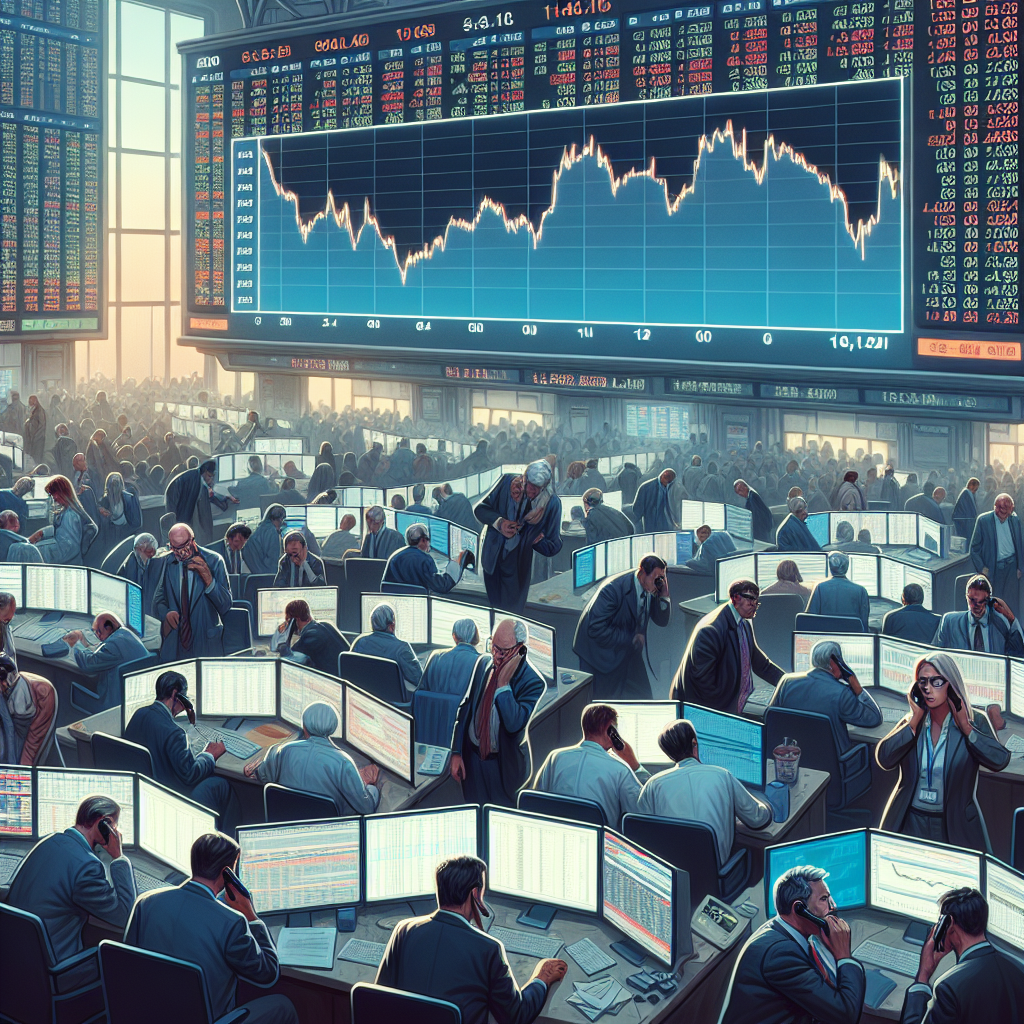“Volatility Reigns: Markets Plunge as Geopolitical Tensions Escalate”
Introduction
The ongoing conflict between Russia and Ukraine has sent shockwaves through global financial markets, causing significant volatility and uncertainty. As tensions escalate, traders and investors are on edge, grappling with the potential economic repercussions of the geopolitical strife. The markets have experienced sharp declines, with stocks, commodities, and currencies all reacting to the unfolding situation. Concerns over energy supplies, particularly in Europe, and the broader implications for global trade and economic stability have heightened anxiety among market participants. This tumultuous environment underscores the intricate link between geopolitical events and financial markets, as traders navigate the complexities of risk management in an increasingly unpredictable world.
Impact Of Geopolitical Tensions On Global Markets
The ongoing conflict between Russia and Ukraine has sent ripples through global financial markets, causing significant volatility and uncertainty. As tensions escalate, traders and investors worldwide are on edge, closely monitoring developments and adjusting their strategies accordingly. The geopolitical strife has not only affected the stock markets but has also had far-reaching implications on commodities, currencies, and investor sentiment.
To begin with, stock markets across the globe have experienced sharp declines as the conflict intensifies. Investors, wary of the potential for further escalation, have been quick to pull back from riskier assets, leading to a sell-off in equities. Major indices in Europe and the United States have seen significant drops, reflecting the heightened anxiety among market participants. The uncertainty surrounding the conflict has made it challenging for investors to predict future market movements, resulting in increased volatility and a cautious approach to trading.
In addition to equities, the conflict has also impacted commodity markets, particularly oil and natural gas. Russia is a major exporter of these resources, and any disruption in supply due to geopolitical tensions can have a profound effect on global prices. As a result, oil prices have surged, adding to inflationary pressures already present in many economies. This increase in energy costs has further complicated the economic landscape, as central banks grapple with balancing inflation control and economic growth.
Moreover, the currency markets have not been immune to the effects of the Russia-Ukraine conflict. The uncertainty has led to a flight to safety, with investors seeking refuge in traditionally stable currencies such as the US dollar and the Swiss franc. Consequently, the Russian ruble has faced significant depreciation, exacerbating the economic challenges faced by Russia. This currency volatility has added another layer of complexity for businesses engaged in international trade, as they navigate fluctuating exchange rates and potential disruptions in cross-border transactions.
Furthermore, the geopolitical tensions have had a notable impact on investor sentiment. The fear of a prolonged conflict and its potential to draw in other nations has created an atmosphere of caution and risk aversion. Investors are increasingly seeking safe-haven assets, such as gold and government bonds, to protect their portfolios from potential losses. This shift in sentiment underscores the broader uncertainty that geopolitical conflicts can introduce into financial markets, as participants reassess their risk tolerance and investment strategies.
In light of these developments, policymakers and financial institutions are closely monitoring the situation, aware of the potential for further market disruptions. Central banks, in particular, face a delicate balancing act as they consider the implications of the conflict on monetary policy. While some may be inclined to tighten policy to combat rising inflation, others may opt for a more accommodative stance to support economic growth amid heightened uncertainty.
In conclusion, the Russia-Ukraine conflict has underscored the profound impact that geopolitical tensions can have on global financial markets. As traders and investors navigate this challenging environment, they must remain vigilant and adaptable, ready to respond to rapidly changing circumstances. The situation serves as a stark reminder of the interconnectedness of global markets and the importance of geopolitical stability in fostering economic prosperity. As the conflict continues to unfold, its effects on financial markets will undoubtedly remain a focal point for market participants and policymakers alike.
How The Russia-Ukraine Conflict Is Shaping Investor Sentiment
The ongoing conflict between Russia and Ukraine has cast a long shadow over global financial markets, creating a climate of uncertainty that has left traders on edge. As tensions escalate, investors are grappling with the potential economic repercussions, leading to significant market volatility. The geopolitical strife has not only disrupted regional stability but has also sent ripples across the global economy, influencing investor sentiment in profound ways.
To begin with, the conflict has exacerbated existing supply chain disruptions, particularly in the energy sector. Russia, a major exporter of oil and natural gas, plays a crucial role in the global energy market. The imposition of sanctions by Western nations has further complicated the situation, leading to fears of energy shortages and driving up prices. Consequently, energy stocks have experienced heightened volatility, with investors closely monitoring developments in the region. This uncertainty has prompted a flight to safety, with many investors seeking refuge in traditional safe-haven assets such as gold and government bonds.
Moreover, the conflict has heightened inflationary pressures, which were already a concern for central banks worldwide. The surge in energy prices has contributed to rising costs for businesses and consumers alike, complicating monetary policy decisions. Central banks are now faced with the delicate task of balancing inflation control with the need to support economic growth. This precarious situation has led to increased speculation about interest rate hikes, further unsettling investors who are wary of the potential impact on corporate earnings and economic expansion.
In addition to energy markets, the conflict has also affected agricultural commodities. Ukraine, often referred to as the “breadbasket of Europe,” is a significant exporter of wheat and other grains. The disruption of agricultural exports from the region has led to concerns about food security and rising prices, particularly in countries heavily reliant on imports. This has added another layer of complexity to the global economic landscape, influencing investor sentiment and contributing to market instability.
Furthermore, the conflict has underscored the importance of geopolitical risk assessment in investment strategies. Investors are increasingly factoring in geopolitical considerations when making decisions, recognizing that such events can have far-reaching implications for global markets. This shift in focus has led to a reevaluation of portfolios, with some investors opting to reduce exposure to riskier assets in favor of more stable investments.
Despite the challenges posed by the Russia-Ukraine conflict, it is important to note that markets are inherently resilient. Historically, geopolitical events have caused short-term disruptions, but markets have typically rebounded over time. However, the current situation is unique in its complexity and potential for prolonged instability, making it difficult to predict the long-term impact on investor sentiment.
In conclusion, the Russia-Ukraine conflict has undeniably shaped investor sentiment, creating a climate of uncertainty and volatility in global markets. The interplay of geopolitical tensions, energy supply concerns, inflationary pressures, and agricultural disruptions has left traders on edge, prompting a cautious approach to investment decisions. As the situation continues to evolve, investors will need to remain vigilant, adapting their strategies to navigate the challenges and opportunities that lie ahead. The path forward is fraught with uncertainty, but with careful analysis and strategic planning, investors can weather the storm and emerge stronger in the face of adversity.
Safe Haven Assets: Where Traders Are Turning Amid Uncertainty
In the wake of escalating tensions between Russia and Ukraine, global financial markets have experienced significant volatility, prompting traders to seek refuge in safe haven assets. As geopolitical uncertainties mount, investors are increasingly wary of the potential economic repercussions, leading to a flight to safety. This shift in investment strategy underscores the critical role that safe haven assets play during periods of heightened uncertainty.
Traditionally, safe haven assets are those that retain or increase in value during times of market turbulence. Gold, often regarded as the quintessential safe haven, has seen a surge in demand as traders look to hedge against geopolitical risks. The precious metal’s historical resilience in the face of economic and political instability makes it an attractive option for investors seeking to preserve capital. Moreover, gold’s intrinsic value and limited supply further bolster its appeal as a reliable store of wealth.
In addition to gold, government bonds, particularly those issued by stable economies, have also garnered attention. U.S. Treasury bonds, for instance, are widely considered a benchmark for safety due to the perceived stability and creditworthiness of the United States government. As traders anticipate potential disruptions in global trade and economic activity, the demand for these bonds has increased, driving yields lower. This inverse relationship between bond prices and yields highlights the market’s preference for security over returns in uncertain times.
Furthermore, the Swiss franc and the Japanese yen have emerged as favored currencies among traders seeking safe havens. Both currencies are traditionally viewed as stable due to their respective countries’ strong economic fundamentals and prudent fiscal policies. As a result, the demand for these currencies has risen, reflecting a broader trend of investors diversifying their portfolios to mitigate risk. The appreciation of the Swiss franc and the yen against other major currencies underscores the market’s cautious sentiment.
While safe haven assets offer a degree of protection, it is essential for traders to remain vigilant and adaptable. The dynamic nature of geopolitical conflicts means that market conditions can change rapidly, necessitating a proactive approach to risk management. Diversification remains a key strategy, as it allows investors to spread risk across various asset classes and geographic regions. By maintaining a balanced portfolio, traders can better navigate the uncertainties that accompany geopolitical tensions.
Moreover, it is crucial for investors to stay informed about developments in the Russia-Ukraine conflict and their potential implications for global markets. Geopolitical events can have far-reaching consequences, affecting everything from commodity prices to supply chain dynamics. As such, traders must continuously assess the evolving landscape and adjust their strategies accordingly. This proactive approach not only helps mitigate risk but also positions investors to capitalize on potential opportunities that may arise from market dislocations.
In conclusion, the ongoing Russia-Ukraine conflict has underscored the importance of safe haven assets in providing stability amid uncertainty. As traders grapple with the potential economic fallout, gold, government bonds, and stable currencies have emerged as preferred options for preserving capital. However, the fluid nature of geopolitical events necessitates a vigilant and adaptable approach to investment. By staying informed and maintaining a diversified portfolio, traders can better navigate the challenges posed by geopolitical tensions and safeguard their investments in an unpredictable world.
Analyzing The Volatility In Commodity Prices During The Crisis

The ongoing conflict between Russia and Ukraine has sent shockwaves through global markets, causing significant volatility in commodity prices. As tensions escalate, traders find themselves on edge, grappling with the uncertainty that accompanies geopolitical strife. The impact of this conflict on commodity markets is multifaceted, affecting everything from energy resources to agricultural products. Understanding the dynamics at play requires a closer examination of the factors driving this volatility and the potential long-term implications for global trade.
To begin with, the energy sector has been particularly sensitive to the developments in Eastern Europe. Russia, a major player in the global energy market, is one of the world’s largest producers of oil and natural gas. The conflict has raised concerns about potential disruptions to supply chains, leading to fluctuations in oil prices. Traders are acutely aware that any escalation could result in sanctions or blockades, further constraining supply and driving prices upward. Consequently, the market has experienced heightened volatility as investors react to each new development in the region.
In addition to energy, agricultural commodities have also been affected by the conflict. Ukraine, often referred to as the “breadbasket of Europe,” is a significant exporter of grains such as wheat and corn. The ongoing hostilities have disrupted farming activities and export routes, leading to concerns about global food security. As a result, prices for these essential commodities have seen considerable fluctuations, with traders closely monitoring the situation for any signs of resolution or further escalation.
Moreover, the conflict has had a ripple effect on other commodities, including metals. Russia is a key supplier of various metals, such as palladium and nickel, which are crucial for industries ranging from automotive to electronics. The uncertainty surrounding the conflict has led to fears of supply shortages, causing price spikes and increased market volatility. Traders are left to navigate these turbulent waters, attempting to anticipate the potential impact on supply chains and adjust their strategies accordingly.
Furthermore, the geopolitical tensions have also influenced currency markets, which in turn affect commodity prices. The Russian ruble and Ukrainian hryvnia have experienced significant fluctuations, impacting trade dynamics and adding another layer of complexity for traders. As currencies fluctuate, the cost of importing and exporting commodities is affected, further contributing to market instability. This interconnectedness underscores the challenges faced by traders as they attempt to manage risk in an increasingly volatile environment.
In light of these developments, traders are employing various strategies to mitigate risk and capitalize on potential opportunities. Hedging, for instance, has become a crucial tool for managing exposure to price fluctuations. By using financial instruments such as futures and options, traders can lock in prices and protect themselves against adverse market movements. Additionally, diversification of portfolios is another strategy being employed to spread risk across different asset classes and reduce vulnerability to any single market shock.
Looking ahead, the resolution of the Russia-Ukraine conflict remains uncertain, and with it, the future trajectory of commodity prices. Traders will continue to monitor geopolitical developments closely, as any changes in the situation could have far-reaching implications for global markets. In the meantime, the volatility observed in commodity prices serves as a stark reminder of the interconnectedness of global economies and the profound impact that geopolitical events can have on market dynamics. As traders navigate these challenging times, their ability to adapt and respond to rapidly changing conditions will be crucial in managing risk and seizing opportunities in an unpredictable landscape.
The Role Of Sanctions In Market Fluctuations
The ongoing conflict between Russia and Ukraine has sent ripples through global markets, causing significant fluctuations that have left traders on edge. Central to these market dynamics is the role of economic sanctions, which have been employed as a strategic tool by Western nations to exert pressure on Russia. These sanctions, while aimed at curbing aggressive actions, have inadvertently contributed to market volatility, affecting everything from energy prices to currency valuations.
Economic sanctions are designed to restrict a nation’s ability to engage in international trade and finance, thereby weakening its economic stability. In the case of Russia, sanctions have targeted key sectors such as energy, finance, and defense. These measures have led to a reduction in foreign investment and have restricted access to international financial markets. As a result, the Russian economy has faced significant challenges, which in turn have had a cascading effect on global markets. The interconnectedness of the global economy means that disruptions in one region can quickly spread to others, creating a climate of uncertainty that traders find difficult to navigate.
One of the most immediate impacts of sanctions has been on energy markets. Russia is a major exporter of oil and natural gas, and any restrictions on its ability to sell these commodities can lead to supply shortages and price spikes. The uncertainty surrounding the availability of Russian energy exports has caused oil prices to fluctuate wildly, affecting not only energy companies but also industries that rely heavily on oil and gas. This volatility has been exacerbated by the fact that alternative sources of energy are not always readily available, making it difficult for markets to stabilize.
In addition to energy markets, financial markets have also been significantly affected by the sanctions. The restrictions on Russian banks and financial institutions have led to a decrease in liquidity, making it more challenging for businesses to secure financing. This has had a ripple effect on global stock markets, as investors become increasingly risk-averse and seek safer assets. The resulting sell-off in equities has contributed to market instability, with indices experiencing sharp declines and recoveries in response to the latest developments in the conflict.
Currency markets have not been immune to the effects of sanctions either. The Russian ruble has experienced significant depreciation as a result of reduced foreign investment and capital flight. This depreciation has made imports more expensive for Russian consumers, further straining the domestic economy. Meanwhile, other currencies, such as the US dollar and the euro, have experienced increased demand as investors seek safe-haven assets. This shift in currency valuations has added another layer of complexity to the already volatile market environment.
In conclusion, the role of sanctions in market fluctuations cannot be understated. While they serve as a critical tool for exerting political pressure, their economic consequences are far-reaching and complex. Traders must navigate a landscape fraught with uncertainty, as the interplay between geopolitical tensions and economic policy continues to drive market dynamics. As the Russia-Ukraine conflict persists, the global economy remains on edge, with the potential for further market disruptions looming on the horizon. Understanding the intricate relationship between sanctions and market behavior is essential for stakeholders seeking to mitigate risks and capitalize on opportunities in this challenging environment.
Strategies For Traders Navigating Geopolitical Risks
In the wake of escalating tensions between Russia and Ukraine, global financial markets have experienced significant volatility, leaving traders on edge as they navigate the complexities of geopolitical risks. The conflict has not only heightened uncertainty but also underscored the intricate relationship between international politics and market dynamics. As traders grapple with these challenges, developing effective strategies to manage geopolitical risks becomes paramount.
One of the primary strategies for traders is to maintain a diversified portfolio. Diversification acts as a buffer against market volatility by spreading investments across various asset classes, sectors, and geographical regions. This approach minimizes the impact of adverse events in any single market or sector, thereby reducing overall risk. For instance, while equities in Eastern Europe may be under pressure due to the conflict, investments in other regions or asset classes, such as commodities or bonds, might offer stability or even growth opportunities. By diversifying, traders can better withstand the shocks that geopolitical tensions often bring.
In addition to diversification, staying informed is crucial for traders navigating geopolitical risks. The rapidly changing nature of international conflicts necessitates a keen awareness of current events and their potential market implications. Traders should regularly monitor news outlets, government statements, and expert analyses to gain insights into the evolving situation. This information can help traders anticipate market movements and adjust their strategies accordingly. Moreover, subscribing to specialized geopolitical risk assessments can provide traders with a more nuanced understanding of potential threats and opportunities.
Another effective strategy is the use of hedging techniques to protect against adverse market movements. Hedging involves taking positions in financial instruments that offset potential losses in other investments. For example, traders might use options or futures contracts to hedge against declines in stock prices or currency fluctuations. By employing these instruments, traders can mitigate the impact of geopolitical events on their portfolios, thereby preserving capital and maintaining stability in uncertain times.
Furthermore, maintaining a long-term perspective is essential for traders dealing with geopolitical risks. While short-term market reactions to geopolitical events can be severe, they often do not reflect the underlying fundamentals of the affected markets. Traders who focus on long-term trends and fundamentals are better positioned to weather temporary volatility and capitalize on eventual market recoveries. This approach requires patience and discipline, as well as a willingness to look beyond immediate market noise.
Incorporating risk management practices is also vital for traders in volatile geopolitical environments. Setting stop-loss orders, for instance, can help limit potential losses by automatically selling a security when it reaches a predetermined price. Additionally, traders should regularly review and adjust their risk tolerance levels to ensure they align with their investment goals and the current market environment. By proactively managing risk, traders can protect their portfolios from significant downturns and maintain a more stable investment trajectory.
In conclusion, the Russia-Ukraine conflict has highlighted the importance of strategic planning for traders facing geopolitical risks. By diversifying portfolios, staying informed, employing hedging techniques, maintaining a long-term perspective, and incorporating robust risk management practices, traders can navigate the complexities of geopolitical tensions more effectively. While the path may be fraught with challenges, these strategies offer a framework for managing uncertainty and seizing opportunities in an ever-changing global landscape.
Long-term Economic Implications Of The Russia-Ukraine Conflict
The ongoing conflict between Russia and Ukraine has sent ripples through global markets, leaving traders and investors on edge as they grapple with the uncertainty of long-term economic implications. As tensions escalate, the immediate impact on financial markets is evident, with stock indices experiencing significant volatility and commodity prices, particularly oil and gas, witnessing sharp fluctuations. However, beyond these immediate market reactions, the conflict poses deeper, more enduring economic challenges that could reshape global economic dynamics.
To begin with, the disruption of trade routes and supply chains is a critical concern. Ukraine and Russia are pivotal players in the global supply of essential commodities, including wheat, corn, and energy resources. The conflict has already led to disruptions in the export of these goods, causing price surges and supply shortages worldwide. This situation is exacerbated by the imposition of sanctions on Russia by Western nations, which, while intended to exert economic pressure, also contribute to the instability of global supply chains. Consequently, countries heavily reliant on these imports are compelled to seek alternative sources, potentially at higher costs, thereby affecting their economic stability and growth prospects.
Moreover, the conflict has significant implications for energy markets. Europe, in particular, finds itself in a precarious position due to its dependence on Russian natural gas. The uncertainty surrounding the continuity of gas supplies has prompted European nations to accelerate their transition to alternative energy sources, a move that, while beneficial in the long term, entails substantial short-term costs and logistical challenges. This shift could lead to increased energy prices, further fueling inflationary pressures that are already a concern for many economies grappling with post-pandemic recovery.
In addition to these supply chain and energy market disruptions, the conflict has broader geopolitical ramifications that could alter the landscape of international trade and investment. The realignment of global alliances and the potential for a protracted standoff between Russia and Western nations may lead to the emergence of new trade blocs and economic partnerships. Such shifts could redefine trade routes and investment flows, impacting global economic growth patterns. For instance, countries may seek to diversify their trade partners to mitigate risks associated with geopolitical tensions, leading to a reconfiguration of global trade networks.
Furthermore, the conflict underscores the vulnerability of emerging markets to external shocks. Many developing economies, already burdened by debt and struggling with the economic fallout of the COVID-19 pandemic, are particularly susceptible to the adverse effects of rising commodity prices and disrupted trade. These challenges could hinder their recovery efforts and exacerbate existing economic disparities, necessitating international cooperation and support to navigate the turbulent economic landscape.
In conclusion, while the immediate market reactions to the Russia-Ukraine conflict are characterized by volatility and uncertainty, the long-term economic implications are profound and multifaceted. The disruption of supply chains, shifts in energy markets, geopolitical realignments, and the vulnerability of emerging economies all contribute to a complex economic environment that requires careful navigation. As traders and investors remain on edge, policymakers and global leaders must work collaboratively to address these challenges, ensuring that the global economy emerges resilient and adaptable in the face of ongoing geopolitical tensions.
Q&A
1. **Question:** What are the primary reasons for the market tumble amid the Russia-Ukraine conflict?
– **Answer:** The primary reasons include geopolitical instability, potential disruptions in energy supplies, and investor uncertainty leading to risk aversion.
2. **Question:** How has the conflict affected global energy markets?
– **Answer:** The conflict has led to increased volatility in energy markets, with concerns over supply disruptions causing spikes in oil and natural gas prices.
3. **Question:** What sectors are most impacted by the market downturn?
– **Answer:** Sectors most impacted include energy, financials, and industries reliant on stable geopolitical conditions, such as manufacturing and transportation.
4. **Question:** How are traders reacting to the ongoing conflict?
– **Answer:** Traders are on edge, often shifting towards safer assets like gold and government bonds, and reducing exposure to riskier equities.
5. **Question:** What measures are central banks considering in response to the market instability?
– **Answer:** Central banks are considering measures such as interest rate adjustments and liquidity support to stabilize financial markets.
6. **Question:** How has the conflict influenced currency markets?
– **Answer:** The conflict has led to increased demand for safe-haven currencies like the US dollar and Swiss franc, while currencies of countries directly involved or nearby have weakened.
7. **Question:** What are the potential long-term impacts of the conflict on global markets?
– **Answer:** Potential long-term impacts include sustained higher energy prices, shifts in global trade patterns, and increased defense spending affecting fiscal policies.
Conclusion
The ongoing Russia-Ukraine conflict has significantly impacted global financial markets, leading to heightened volatility and uncertainty. Traders are on edge as geopolitical tensions exacerbate existing economic challenges, such as supply chain disruptions and inflationary pressures. The conflict has led to sharp declines in stock markets, increased energy prices, and fluctuations in currency values, reflecting investor anxiety and risk aversion. As the situation evolves, market participants remain cautious, closely monitoring developments and adjusting their strategies to navigate the turbulent environment. The conflict underscores the interconnectedness of global markets and the profound impact geopolitical events can have on economic stability and investor sentiment.





